welcome to worldwidewachs.com
PAGE 3
August 20, 2003
 Cochabamba,
the city of eternal spring, is finally coming into its own. As the winter gratefully fades away, the brilliant purple jacaranda makes
its showy comeback, vibrant new blossoms bursting out bravely on every street
and boulevard, sassy bright against the crystal blue skies.The blazing red, orange and purple bougainvillea, which trudged
faithfully through the winter, glows even more brilliantly in the beaming sun. The days are basking warm now, and the nights but a soft coolness
drifting through, as though to refresh the dusky evenings as darkness steals over the mountains.
Cochabamba,
the city of eternal spring, is finally coming into its own. As the winter gratefully fades away, the brilliant purple jacaranda makes
its showy comeback, vibrant new blossoms bursting out bravely on every street
and boulevard, sassy bright against the crystal blue skies.The blazing red, orange and purple bougainvillea, which trudged
faithfully through the winter, glows even more brilliantly in the beaming sun. The days are basking warm now, and the nights but a soft coolness
drifting through, as though to refresh the dusky evenings as darkness steals over the mountains.
Now that the orphanage-building project is over for this session, our life in Cochabamba inches
 forward, and the days are long, but not always full. We’ve returned to CEOLI to work in the mornings. There is only intermittent translation work, and I wander back to the
classroom area to see if I am needed. But there are only sporadic tasks, occasional drawing or crafts projects with the
kids, and long pauses of waiting and watching. Marvin has been doing some artwork of his own, drawing items that begin
with the letters “L” and “M” to make an illustrated phonics aid. He has his very own box of crayons now – 24 shiny new ones in assorted
colors.
forward, and the days are long, but not always full. We’ve returned to CEOLI to work in the mornings. There is only intermittent translation work, and I wander back to the
classroom area to see if I am needed. But there are only sporadic tasks, occasional drawing or crafts projects with the
kids, and long pauses of waiting and watching. Marvin has been doing some artwork of his own, drawing items that begin
with the letters “L” and “M” to make an illustrated phonics aid. He has his very own box of crayons now – 24 shiny new ones in assorted
colors.
We’ve been racking our brains to think of ways we can be more useful at CEOLI, and we’ve chosen a planting project – helping the kids grow flowers and vegetables.Ron, the director, has given us the enthusiastic go-ahead, so we’ve plunged forward with plans and obtaining supplies.
But life simply moves more slowly here, and time is just time – not money or an enemy of accomplishment. So we live at this different speed, absorbing its rhythm, adapting to the long stretches of easy, languid hours. The 3-hour midday siesta fosters a relaxed family meal with sharing of events, and a lingering cup of mate (herbal tea) at its close.Incredibly, I have never seen a cup of coffee or tea here in a Styrofoam or thermal paper cup. To my knowledge, there is no place to buy such a thing. Coffee and tea are to be savored in china cups, sitting down and relaxing, in conversation with friends or relatives.
There is plenty of time during the siesta for more talking, reading, studying or just plain play, before easing toward the afternoon’s activities. Sundays are reserved for families. The entire rest of the world stops, while families and extended families visit, talk, play and spend the entire afternoon together. For Bolivians, being with friends and family is its own purpose, the joy and pleasure that fills them up, spilling over to every other facet of their lives. But Marvin and I don’t know how to do this, really. We go through the motions, imitating the actions and trying to capture the emotions, but there is always that faintly beating undercurrent of anxiety and hurry-upness from some vague former life.
The simpleness of this life suits in some ways. There are long stretches to ponder and sort out ideas, and lingering discussions over an extra cup of tea. We have time to walk everywhere, and the city has become ours as we notice and absorb its activities and subtle changes:the guards on our walk to class expect and greet us with smiles, the flowers in the plaza at the bridge are being replanted, they are painting the gate at the yellow house on the Prado, the street vendor on Calle Sajama has not been there for 2 days. The rich and varied street smells are a riotous carnival for the senses, the fresh bread at the bakery on Santa Cruz, the peeled oranges from the vendor on the corner of Antezana and Sucre, freshly popped popcorn, unknown aromas wafting from street side restaurants.
But the quietness, the almost deafening solitude of so few other people and communication devices around us weighs heavily, and long evenings alone are the hardest. Without TV or newspapers with world news, we’re barely connected to anyone outside Bolivia, light-years away from the U.S. war on terrorism, deteriorating U.S. – world relations, presidential politics, the latest celebrity scandal. And yet, what would we do about it except brood and debate.
September 1, 2003
Well, life has picked up amazingly. Stage one of the planting project with the CEOLI kids was chaotic and wildly successful.Twenty kids at once, with varying degrees of manual dexterity and understanding, clamoring for pansy, snap dragon, marigold, zinnia, tomato or oregano seeds, stuffing them into the soil in their little plastic cartons, labeling the cartons with their names and seeds. Their enthusiasm was contagious, the more mobile ones helping those who couldn’t plant on their own, and the older kids from other classes hovering around to offer advice and comments. It was so popular that Marvin and I bought more seeds and we all did a second round of planting 2 days later.
Now comes the hardest part for the kids – waiting patiently for something to happen. But already, in just a few days, we’re seeing the first brave shoots poking out of the soil. When the plants grow high enough, we’ll transplant them to a garden in the front yard of CEOLI, a beautiful space we’ll create right at the entrance, where everyone who passes by will see the kids’ creations, and where the kids will do the ongoing care taking.
Ron was
 so excited about the gardening idea that he asked if we would landscape the entire front yard. We
so excited about the gardening idea that he asked if we would landscape the entire front yard. We
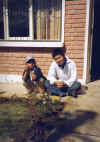 agreed, of course, and immediately applied ourselves to our new project, scouring La Cancha and the local greenhouses for mulch and
flowers, designing the shape and extent of the flowerbeds, studying the amount of shade and sun.In the end, we
dug a foot wide path along either side of the sidewalk up to the building, then a T-shaped strip along the front.When
the path was dug, several of the higher-functioning kids helped us plant the flowers – begonias, marigolds and trabajadoras, interspersed with a
beautiful low tri-colored leaf plant whose name we never learned. Everyone at the center is ecstatic over the transformation of
their new entrance way, as though before it was
somehow lacking, and now it is finally the proud entrance it should have been all along.
agreed, of course, and immediately applied ourselves to our new project, scouring La Cancha and the local greenhouses for mulch and
flowers, designing the shape and extent of the flowerbeds, studying the amount of shade and sun.In the end, we
dug a foot wide path along either side of the sidewalk up to the building, then a T-shaped strip along the front.When
the path was dug, several of the higher-functioning kids helped us plant the flowers – begonias, marigolds and trabajadoras, interspersed with a
beautiful low tri-colored leaf plant whose name we never learned. Everyone at the center is ecstatic over the transformation of
their new entrance way, as though before it was
somehow lacking, and now it is finally the proud entrance it should have been all along.
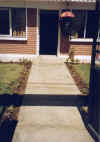 Only a few days into the planting projects, Ron announced we needed to paint a huge old
Only a few days into the planting projects, Ron announced we needed to paint a huge old
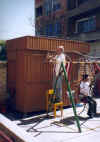 metal kiosk that was at one end of the cement play area.In the next breath, he asked if we would build a brick wall on the other
side of the play area – 6 feet high by about 300 feet long .Pleased about having new projects to do, we enthusiastically accepted.
metal kiosk that was at one end of the cement play area.In the next breath, he asked if we would build a brick wall on the other
side of the play area – 6 feet high by about 300 feet long .Pleased about having new projects to do, we enthusiastically accepted.
And that’s not all. Ron also asked me to teach a conversational English class to the professional staff at CEOLI for an hour each morning. (This means going to CEOLI an hour earlier than before.) I agreed to do this, then discovered in the first class that 2 of the teachers were absolute beginners and would not be able to keep up with the others. Marvin agreed to teach them in a separate class, if I would prepare their lesson plans.
Only the day before, Marcella, Lucy’s sister who lives next door to us, had asked me to spend an hour with her each evening to converse and help her improve her English. She works for LAB, the Bolivian airline, and was recently promoted to a job where English is vitally important. And I’m now also helping Jean Carla’s stepmother, Pochita, who is working on a master’s degree in English, decipher some intricate teaching theories and methods in English that even I do not understand.
All these activities stretch the days a bit more, from 8:00 in the morning to 8:00 or 8:30 at night, with lesson planning squeezed in between. But there is still no urgency, no time clock marking the start and stop of class, no life or death importance to weigh you down. The comfortable, easy-going Bolivian pace is still there; it just starts earlier and ends later each day.
September 13, 2003
We interrupted our various projects with a 10-day trip to Sucre and Potosi. Potosi is a fascinating, yet tragic city. At 4100 meters (over 13,300 feet) high, it is called the highest city in the world, set in a barren, desolate, cold expanse of altiplano. In the 17th century nearby Cerro Rico Mountain was so rich in silver that Potosi was the center of the world’s silver-mining industry, and boasted of being one of the largest and wealthiest cities in the world – bigger and more important than even Madrid and London.
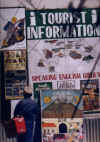 When the silver veins were exhausted several centuries ago, they began mining tin.
But the tin industry collapsed in the late 1900s, and the town is a shell
of its former self; ornate and intricate colonial architecture with no one but
the tourists left to appreciate its faded glory.
The huge and magnificent La Casa de la Moneda (the Coin or Money House)
where they made silver coins was a fascinating lesson in history.
And the churches and convents still count among their treasures the
intricate vases, detailed sculptures, elaborate picture frames and ornate
furniture of the finest porcelain, alabaster, marble, silver and gold leaf.
The vestige of wealth in such a poor, forgotten city is overwhelming.
When the silver veins were exhausted several centuries ago, they began mining tin.
But the tin industry collapsed in the late 1900s, and the town is a shell
of its former self; ornate and intricate colonial architecture with no one but
the tourists left to appreciate its faded glory.
The huge and magnificent La Casa de la Moneda (the Coin or Money House)
where they made silver coins was a fascinating lesson in history.
And the churches and convents still count among their treasures the
intricate vases, detailed sculptures, elaborate picture frames and ornate
furniture of the finest porcelain, alabaster, marble, silver and gold leaf.
The vestige of wealth in such a poor, forgotten city is overwhelming.


 Sucre, a colonial city of 200,000 at only 9100 feet
high, is the capital of Bolivia in name, but in practice. It is charming and refined, its all-white downtown
colonial buildings declared a UNESCO world heritage site in 1991.From the vibrant and spacious central Plaza 25 de Mayo to the
imposing Neoclassical Alcaldia Municipal and elegant Casa de la Libertad and the 17th
century churches everywhere along narrow colonial streets, it is picturesque, interesting and almost bustling.There
are museums galore – artifacts, furniture and décor, and indigenous textiles and handcrafts. Just outside of town, we saw the largest site of dinosaur
footprints in the world.
Sucre, a colonial city of 200,000 at only 9100 feet
high, is the capital of Bolivia in name, but in practice. It is charming and refined, its all-white downtown
colonial buildings declared a UNESCO world heritage site in 1991.From the vibrant and spacious central Plaza 25 de Mayo to the
imposing Neoclassical Alcaldia Municipal and elegant Casa de la Libertad and the 17th
century churches everywhere along narrow colonial streets, it is picturesque, interesting and almost bustling.There
are museums galore – artifacts, furniture and décor, and indigenous textiles and handcrafts. Just outside of town, we saw the largest site of dinosaur
footprints in the world.
 We
spent a weekend at Bramadero, a lodge and cabins in the country, where we hiked in the mountains, feasted on gourmet meals served family style
in a gracious dining room, and met other guests from England, Ireland, Argentina, Bolivia and the U.S. All in all it was a lovely trip, a good break, and another glimpse into life in Bolivia. But it came to me while we were traveling the barren, dusty
altiplano between Sucre and Potosi, mile after mile of crumbling adobe ho
We
spent a weekend at Bramadero, a lodge and cabins in the country, where we hiked in the mountains, feasted on gourmet meals served family style
in a gracious dining room, and met other guests from England, Ireland, Argentina, Bolivia and the U.S. All in all it was a lovely trip, a good break, and another glimpse into life in Bolivia. But it came to me while we were traveling the barren, dusty
altiplano between Sucre and Potosi, mile after mile of crumbling adobe ho mes spread out before us, peasants trudging along the road or through the fields, homeless
dogs, dry parched fields, towering mountains.
mes spread out before us, peasants trudging along the road or through the fields, homeless
dogs, dry parched fields, towering mountains.
 And we were comfy in the backseat of a Nissan sedan, with the sweet,
mellow music of Elton John crooning in the background. It came to me that in the U.S. we live our lives in nuggets of comfort, a
series of unconscious habits, from the just-right temperature and strength of our morning coffee, to the way we fold the daily newspaper, make our bed, set
the table, listen to carefully selected music as we drive. We get things just right, arranged the way we want them, the right shade
of pillow on the sofa, the temperature of the living room in the late afternoon, the books and magazines stored or stacked just so.It creeps up on us, this carefully arranged order of things, like the
days slide silently by while we’re too busy looking the other way, quietly,
subtly changing our world without us even knowing.
And we were comfy in the backseat of a Nissan sedan, with the sweet,
mellow music of Elton John crooning in the background. It came to me that in the U.S. we live our lives in nuggets of comfort, a
series of unconscious habits, from the just-right temperature and strength of our morning coffee, to the way we fold the daily newspaper, make our bed, set
the table, listen to carefully selected music as we drive. We get things just right, arranged the way we want them, the right shade
of pillow on the sofa, the temperature of the living room in the late afternoon, the books and magazines stored or stacked just so.It creeps up on us, this carefully arranged order of things, like the
days slide silently by while we’re too busy looking the other way, quietly,
subtly changing our world without us even knowing.
Living like a Bolivian in a third world country changes all that. It disrupts all the familiar habits and comforts you didn’t know you had, deprives you of their order and pleasure, offering something less satisfactory in their place. Because there isn’t as much here; sometimes there are no choices at all. And it is a netherworld, this odd, emptier, yet interesting feeling that comes over you. Your previous life is gone, all the familiar possessions, the comfortable habits, the careful order, the knowing who you were. You don’t even live in the same words – grappling amid the thoughts and expressions of another language.
You have to start all over, reinvent the person you’ll be here, without all the accoutrements you once had. And you find your way ever so slowly, gradually acquiring new habits, discovering a different person who was inside you all along. You struggle to remember who you used to be, but there is a haziness about it, a fuzzy layer you can’t quite permeate. And you wonder who you’ll be when you get back home – which nuggets of comfort or habit you’ll sink into immediately, and which will quietly disappear, unnecessary or unwanted now inside the new person you’ve become.
Marvin writes:
I have never lived in the mountains. Living in Cochabamba is quite a change from the rolling blue grass of Kentucky, or the view across Kansas from my home in Joplin. Cochabamba is in a valley surrounded by mountains. It is like living in a bowl. As we walk back from Spanish class or the supermarket I get to watch the mountains.The play of light on the folds and creases at various times of day keeps me infinitely entertained. Before we go, I have to finish my climb to Lake Tunari. (We had to return at Kilometer 9 of 13). I am beginning to understand Martie, who grew up in Western Maryland, wanting to vary Joplin’s vista, wanting to go to the mountains.
Although I have been looking at and remarking on gates and entryways all along, last week I
started to photograph examples. Cochabambinos approach security from two directions: There
is a cottage industry
 of neighbor
of neighbor hood guards armed with a sheaf knife, a Billy
club and a whistle, and every house in town has its own wall. It is illegal to share a wall, so each must build one on adjoining lot
lines. The wall, by design or default, is the world’s view of the people inside. Walls are brick, stone, concrete and ironwork erected in any combination
to reflect the individual inside. And the gates allow for even more individuality. At one end of the spectrum is the common brick wall, unpainted,
with broken glass imbedded at the top, and a gate of welded rebar with sheet tin wired to it. At the other end of
the spectrum the monied gentry have a designer rock wall with stucco over brick, filigreed ironwork and most often topped with bent, pointed rods on top. The gates are often stained inlaid wooden structures with massive wrought
iron hinges and handles; very reminiscent of their cousins, closing castle keeps.
hood guards armed with a sheaf knife, a Billy
club and a whistle, and every house in town has its own wall. It is illegal to share a wall, so each must build one on adjoining lot
lines. The wall, by design or default, is the world’s view of the people inside. Walls are brick, stone, concrete and ironwork erected in any combination
to reflect the individual inside. And the gates allow for even more individuality. At one end of the spectrum is the common brick wall, unpainted,
with broken glass imbedded at the top, and a gate of welded rebar with sheet tin wired to it. At the other end of
the spectrum the monied gentry have a designer rock wall with stucco over brick, filigreed ironwork and most often topped with bent, pointed rods on top. The gates are often stained inlaid wooden structures with massive wrought
iron hinges and handles; very reminiscent of their cousins, closing castle keeps.
Still, thievery is a thriving profession. Within the first week of our family’s neighbors hiring a guard, a car was stolen while parked in the street. This week thieves came up short trying to penetrate the roof at CEOLI (where we volunteer). They were using a two meter section of half inch pipe* to poke a hole thru the tar. They managed a two or three inch hole before losing their grip on the pipe, dropping it into the office below. Bummer! At La Cancha, a 50 square block open-air market here, there is a section offering stolen goods. Not only was it suggested that I start there when I went shopping for an electric drill**, but when Jean Carla had her windshield stolen, she was able to find an exact replacement there – right down to the distinctive scratch her original had.
Life here is hard for the disenfranchised. I don’t know if life is easier for the thief or the beggar. I don’t see any thieves, but beggars are everywhere. Not only are there campesinos and offspring holding out their hats, but there are kids doing handstands or windshield washing at red lights, as well as jugglers with flaming torches at night. Moving “up” there are vendors with mobile carts, usually oranges or orange juice or puffed grains (local popcorn), kiosks with various candy and cookies, and Mom & Pop stores. Actually they are mostly Mom stores, in a street side room of the house within walking distance of the neighbors. They offer a 7 – 11 smorgasbord of products, with daily fresh bread about 7:30 am. About dark a cell bar door precludes entry, but purchases can still be made through the bars until bedtime. Ain’t no government handouts here. Even the drunks under the bridge have to scratch or die.
* Yes, Paul, they sell English diameter pipe by the metric length.
** Electric drills, as well as other power tools, are sold as “original”, a BOSCH made in Brazil for $50.00 and up or as Brand X for 50 Bolivianos with a BOSCH label stuck on. AND the vendor will tell you which is which.
October 4, 2003
Our major sprucing-up campaign has visually transformed CEOLI, the center for handicapped children. The begonias, marigolds and
trabajadoras in the front yard are bursting with color (although the children’s flowers and
 vegetables have sadly not reached their expected potential). At the entrance, the varnished rock wall glistens in the sun, the newly
painted white cement columns and black metal gate are fresh and shiny. The huge kiosk in the play area is a bold display of red, yellow and
blue. And the brick wall is now 2 meters high and just a day or two from being completed. Two volunteers from Holland have painted one of the classrooms in soft
yellow and blue, and soon there will be newly remodeled bathrooms. Every change, no matter how minor, is enthusiastically welcomed and
appreciated by the children and staff. The center is alive and buzzing with comings and goings and changes.
vegetables have sadly not reached their expected potential). At the entrance, the varnished rock wall glistens in the sun, the newly
painted white cement columns and black metal gate are fresh and shiny. The huge kiosk in the play area is a bold display of red, yellow and
blue. And the brick wall is now 2 meters high and just a day or two from being completed. Two volunteers from Holland have painted one of the classrooms in soft
yellow and blue, and soon there will be newly remodeled bathrooms. Every change, no matter how minor, is enthusiastically welcomed and
appreciated by the children and staff. The center is alive and buzzing with comings and goings and changes.
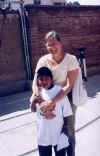 The last two weeks
Marvin and I, and our mason friend Felix have been slaving over the brick wall at CEOLI. We’ve been blessed with
the “help” of two CEOLI students, both named Marco, who have apparently figured out how to escape from their classes whenever it suits them. The older Marco has Down’s syndrome, the younger appears to be retarded
and have mild cerebral palsy. Neither speaks, but they both grunt, and appear to understand some of our instructions,
although they don’t usually follow them. Their “help” consists of such activities as stacking dry (i.e.
unusable) bricks among the wet (i.e. usable) ones, watering the tools, throwing pieces of brick at each other, pouring extra water in the
mezcla so it is too soupy, and peeing in the ditch. The additional “help” adds a combination of frustration and comedy to the task.
The last two weeks
Marvin and I, and our mason friend Felix have been slaving over the brick wall at CEOLI. We’ve been blessed with
the “help” of two CEOLI students, both named Marco, who have apparently figured out how to escape from their classes whenever it suits them. The older Marco has Down’s syndrome, the younger appears to be retarded
and have mild cerebral palsy. Neither speaks, but they both grunt, and appear to understand some of our instructions,
although they don’t usually follow them. Their “help” consists of such activities as stacking dry (i.e.
unusable) bricks among the wet (i.e. usable) ones, watering the tools, throwing pieces of brick at each other, pouring extra water in the
mezcla so it is too soupy, and peeing in the ditch. The additional “help” adds a combination of frustration and comedy to the task.
In the mid-afternoon, the CEOLI kids have long recesses in the adjoining large patio, and I find it one of the most amusing times of the day. Two 3-year-old able-bodied teachers’ sons, who accompany their mothers to work, and one young Down’s syndrome child, push spare miniature walkers around the play area, giggling and laughing as they run into things, as if it were a county-fair game of bumper cars. The less physically-restricted children (usually those with emotional or developmental disorders) push the wheelchairs of the chair-confined children, knocking the chairs into walls, getting stuck in corners and abandoning the chairs and kids in awkward and inescapable positions. This does not appear to be a supervised recess, and since the poor kids are left high and dry with no immediate rescue in sight, we stop working occasionally to extract them from their predicament and put them at the mercy of whoever next comes along. But no one seems to mind, it is all a game and this is the way they play it.
We don’t see as much of 5-year-old Paola, for whom we bought a doll for her birthday, since Paola comes in the afternoons now. Her mother has gone to Spain to look for work, leaving Paola and her younger brother in the care of their father. It is not unusual for families to be split for months or years like this because of the economic problems in Bolivia. Paola doesn’t know anything about economic problems, but she misses her mother terribly, and there is an aura of sadness about her that wasn’t there before.
 Our English classes for the CEOLI staff have been a huge hit, as everyone is so eager to learn
English, and so curious about the U.S. What do we really think about illegals? Is it true that we discriminate more against blacks than Hispanics? Do people in the U.S. support George Bush? I learn amazing things about my own language, while trying to explain it
to others. If the past tense of the verb “live” is “lived”, and the past tense of “want” is “wanted”, why wouldn’t the past tense of “see” be “seed”, and the past tense of “think” be “thinked”? Why do we say “in the morning” and “in the
afternoon”, but “at night”? If the present is “I can do it”, and the past is “I could do it”, why isn’t the future “I will can do it”?
Our English classes for the CEOLI staff have been a huge hit, as everyone is so eager to learn
English, and so curious about the U.S. What do we really think about illegals? Is it true that we discriminate more against blacks than Hispanics? Do people in the U.S. support George Bush? I learn amazing things about my own language, while trying to explain it
to others. If the past tense of the verb “live” is “lived”, and the past tense of “want” is “wanted”, why wouldn’t the past tense of “see” be “seed”, and the past tense of “think” be “thinked”? Why do we say “in the morning” and “in the
afternoon”, but “at night”? If the present is “I can do it”, and the past is “I could do it”, why isn’t the future “I will can do it”?
But Spanish rules are elusive too, and the subjunctive will forever puzzle me, as will the interplay between the two past tenses. We have just completed our last Spanish class. My teacher, Janet, has been a taskmaster and a perfectionist – just the right kind of teacher for me. And I have learned so much. Marvin’s teacher was not not nearly as demanding, nor has he studied as hard. But he can limp along if he has to, order a beer, take a taxi, ask for a bathroom – the essentials of getting around.
It has been three months since we sent our passports off to LaPaz to get our 6-month visas, and we still don’t have them back. The riled campesinos have been blockading the roads around LaPaz for three weeks now, protesting the government’s decision to export Bolivian gas through Chile. Do you suppose our visas and passports are caught in the crazy blockades? Our simple and peaceful request to stay in their country to help the people now a victim of the citizens’ anger against their own government? There is a gradually creeping concern that we won’t get our passports back by November 17, when we are supposed to leave for the states. Jean Carla promises we will have them by then, but how can you make promises like this in such a volatile country? The Santa Cruz, Beni, Pando and Tarija areas of Bolivia are tired of unenforced laws, crooked governments and spontaneous blockades, and want to secede from the rest of the country. It is a crazy and fractured time here, but I wish some government official would experience a moment of sanity and return my visa request and passport.
October 12, 2003
It is our third and last work session at the orphanage. Our group this time, besides Jean Carla, Marvin and me, consists of Joyce – a woman from Kansas City we became friends with on our work trip to Kenya two years ago – and Kristen, a delightful 18-year-old from Calgary, Canada. Our mason, Felix, has two new helpers this time around:his curious and talkative 19-year-old brother Julio, and a quiet, assured and patient young man named Gualberto.
The kids at the orphanage are like always, greeting us with their ever-shy smiles and awkward turns of the body – that wanting to make human contact coupled with a shyness and fear of rejection. But they know us better now, and they say hello more quickly and easily. Eleven-year-old Ever is gone – no one knows where. Who decided to uproot his young life once more and send him elsewhere? Is it with a drunk and abusing distant relative? Because where were the relatives who cared when he was first placed in the orphanage? Ever, I hope your life is better now, but I have my doubts.
This work session our goal is to lay tile in the upstairs floor. Jean Carla has seriously misled us. With her blithe and confident assurance ringing in our heads that laying tile is FUN – one of her FAVORITE JOBS, she says – we set about scraping white plaster gunk off the floor – bits of ceiling that have fallen when the roof was put in. We can’t lay tile until we have scraped this all off, because the tile glue won’t stick to this hard, stubborn white stuff. There are four large rooms and a huge alcove/hallway, and clearly the roofers were not penalized for failing to get the majority of the plaster to stay in the roof. Imagine crouching on all fours on your concrete patio to scrape up a hardened glob of mud, or dousing that stubborn stain in your carpet with spray cleaner and then rubbing like the dickens to get the stain out. Not too bad, huh? Now, try doing it for 3 ½ hours straight in the morning, and another 2 ½ in the afternoon. Once, when I was the only one there because the others were touring the other orphanage buildings, I imagined myself as poor Cinderella, in those long hard days before the fairy godmother and the pumpkin coach came to her rescue.
By the morning of day two, we’ve scrubbed away most of the white stuff, although little patches keep
appearing when we sweep, as though they had furtively multiplied under cover of dust piles. Nevertheless, we begin

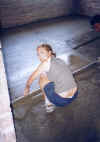 pouring the concrete floor, laying “leveler buttons” in the corner and the center, mixing the concrete in the hallway manually with shovels, starting with
just piles of dry concrete mix, with water in the middle. We pour the concrete in small batches on the floor, cut through the air
pockets with a trowel, smooth out the bumps, and then finally run a long metal bar across, using the buttons and their ridges to keep level.The on-your-knees, constantly-reaching-over position is a real killer,
especially several days in a row. This is clearly a job for four-legged animals. Kangaroos come to mind – their sturdy, strong hind legs could support them easily for
the long hours, although their short little front legs might inhibit the scope of their reach.Bears and elephants would be too clumsy. Dogs would
just wag their tails, then prance happily around in the unset muddily concrete. Actually, a few of the 7-week-old puppies at the orphanage did just that.
pouring the concrete floor, laying “leveler buttons” in the corner and the center, mixing the concrete in the hallway manually with shovels, starting with
just piles of dry concrete mix, with water in the middle. We pour the concrete in small batches on the floor, cut through the air
pockets with a trowel, smooth out the bumps, and then finally run a long metal bar across, using the buttons and their ridges to keep level.The on-your-knees, constantly-reaching-over position is a real killer,
especially several days in a row. This is clearly a job for four-legged animals. Kangaroos come to mind – their sturdy, strong hind legs could support them easily for
the long hours, although their short little front legs might inhibit the scope of their reach.Bears and elephants would be too clumsy. Dogs would
just wag their tails, then prance happily around in the unset muddily concrete. Actually, a few of the 7-week-old puppies at the orphanage did just that.
 So, it is left to us poor humans to struggle along, crouched over the unruly concrete, struggling
mightily to somehow make this water/sand/rock combination look smooth and even. I am not good at this. I
can’t get the concrete the right height – I either press too hard or not enough.Gualberto hovers over me and patiently fixes everything I do. My
tolerance for this joyless task is limited. I suggest to Jean Carla that my talents might be better utilized elsewhere, but she insists I need to learn how to do this, as though my
ineptness at this particular task would be some fatal flaw on a future resume. I persevere, but not without grumbling, and certainly without noticeable
improvement.
So, it is left to us poor humans to struggle along, crouched over the unruly concrete, struggling
mightily to somehow make this water/sand/rock combination look smooth and even. I am not good at this. I
can’t get the concrete the right height – I either press too hard or not enough.Gualberto hovers over me and patiently fixes everything I do. My
tolerance for this joyless task is limited. I suggest to Jean Carla that my talents might be better utilized elsewhere, but she insists I need to learn how to do this, as though my
ineptness at this particular task would be some fatal flaw on a future resume. I persevere, but not without grumbling, and certainly without noticeable
improvement.
 After 2 ½ days, we
finally arrive at the tile-laying stage. It
is far easier physically, although it requires the same crouched-on-the- floor
position, and our body parts have clearly had enough of this; they are in that
whiny, moaning stage where it doesn’t matter what new position you try on
them, they are NOT going to be happy. We keep on working.
After 2 ½ days, we
finally arrive at the tile-laying stage. It
is far easier physically, although it requires the same crouched-on-the- floor
position, and our body parts have clearly had enough of this; they are in that
whiny, moaning stage where it doesn’t matter what new position you try on
them, they are NOT going to be happy. We keep on working.
Kristen and Marvin work with Felix in one of the front rooms, while Joyce, Gualberto and I are in the back room. Julio and Jean Carla are in and out, helping wherever we need it. We spread the cement glue, lay the tile, and then position it with four nails hammered into the cement. This is slow, but more satisfying to me. The tiles actually line up when I am finished, and Gualberto rarely has to fix my mistakes.We spend a day and a half laying tile, and then it is time for a long weekend.
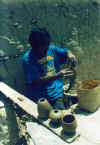
 But this time we must leave for Cochabamba early in the morning to avoid the blockades. There continues to be serious internal strife in the country, and
although it is still mostly centered in LaPaz, Cochabamba is being sucked into the frenzy. Our weekend is spent
mostly outside of Cochabamba, visiting some of the smaller surrounding towns, and then making another scenic trip to the Inca ruins of Incallajta. But this time there are large boulders and remnants of blockades on the
highway. We return to Vinto on Sunday evening under the shadow of Bolivian discontent.
But this time we must leave for Cochabamba early in the morning to avoid the blockades. There continues to be serious internal strife in the country, and
although it is still mostly centered in LaPaz, Cochabamba is being sucked into the frenzy. Our weekend is spent
mostly outside of Cochabamba, visiting some of the smaller surrounding towns, and then making another scenic trip to the Inca ruins of Incallajta. But this time there are large boulders and remnants of blockades on the
highway. We return to Vinto on Sunday evening under the shadow of Bolivian discontent.
October 13, 3002
It has now been four weeks since the campesinos in LaPaz began protesting the exportation of Bolivian gas to the U.S. through Chile. The Bolivians want to keep their gas, and want to be able to buy it at more favorable prices than they currently can. No Bolivian I have talked to trusts the government to act in Bolivians’ best interests. So the volatile and violent Aymaran peasants in LaPaz have been protesting the way Bolivians do, by blockading, then by drinking, and finally by destroying.
The situation has escalated. The campesinos have burned busses, destroyed electric power plants, dynamited roads, and surrounded the city of LaPaz. The military has been called out to quell their activities, but this has resulted in violent confrontations. Now there are countless dead and wounded to fuel the campesinos’ anger. The LaPaz airport is now closed. No food or goods are entering or leaving the city. The campesinos want Bolivia’s president to resign, and are now marching toward the government palace in LaPaz.
We are 400 kilometers (250 miles) away in Vinto, in the departamento (state) of Cochabamba”. There are some blockades in the area here too, but no violence yet. But there is concern, worry, despair among our friends here.We worry with them, listen for the latest tidbits of news, but our concern is different.Will we be able to get to the Hogar tomorrow? Will we have to change our travel plans for this Saturday?Will we be otherwise inconvenienced?
But for Bolivians, the worries are deeper, tugging harder at their inner selves, choking them with the frustration of it all. Because no matter what happens, it is Bolivians destroying Bolivians, the people against their own institutions and government, three steps further backward and none ahead. Their despair is palpable, and my heart hurts with them, because just like them, I have nothing to offer that will change the outcome or the outlook for the future. A different president is only a temporary reprieve; even a less corrupt government will never overcome the deep-seated anger, resentment and distrust of these people. They are tired of being taken advantage of and being lied to by their leaders.And, partly because there is little reliable, factual information available, they have no idea what they would like instead. These are disenchanted people who are against everything their government does, but they don’t know what to be for.They desperately need a clear, unified vision of what to work towards, something that will guide them through the struggle, to emerge with something better than they have now.
On Monday of the second week, we work under the growing threat of blockades and possible violence in the departamento of Cochabamba. We start laying tile in rooms 3 and 4, now a little more confident, our work patterns smoother and settled in this time around. There has been a bit of rain, and the peaks of the near mountains sport a dusting of snow on the ridges. At the end of the workdays, I have been offering sprays of Victoria’s Secret Endless Love body splash to all the orphans who want it. They crowd around me, boys and girls, holding out their skinny brown arms, shouting “aqui tia”, “aqui tia”. They withdraw their hands after I spray them, sniff themselves, and stick their hands back in. I keep spraying until they have all had their fill. They run off sniffing each other and laughing.
October 14, 2003
There are days when your whole world changes in an instant, and today was like that. To get to the orphanage to work, we had to take the dirt back roads because the major highway was blockaded. By early afternoon, Jean Carla decided the threat of more blockades and the risk of violence was elevated enough that we needed to return to Cochabamba city. She announced this to the orphans, and we immediately packed up to leave. I was caught off guard, unprepared for such hurried farewells. The kids stood together and sang us goodbye songs, while tears dripped down my face at the thought of not seeing them again. They have become so much a part of me, one of the major reasons I am in this country, and now these children were being suddenly and unwillingly torn out of my life.
In just a few quick moments we had driven away in the trufi, the children’s shouts and waves fading rapidly behind us.At the Casa de Retiros, we hastily packed our belongings, loaded the trufi, and picked our way to Cochabamba through the remnants of blockades – rock-strewn roads, scattered branches, and torched tires.
The entire country except for the departamento of Santa Cruz will have a paro civico (civilian stoppage) tomorrow. All businesses, transportation, everything will be shut down in support of the campesinos in LaPaz. There will be many marches and demonstrations, and more blockades. The U.S. ambassador has declared support for the Bolivian president, which has fueled anger against the U.S., and Jean Carla will not let us leave the house tomorrow. Canada, Holland and Germany are suggesting their citizens leave Bolivia. This country we came to live in, learn about, find friends in, and help in some small way, has temporarily become our prison.
November 1, 2003
Two weeks ago President Gonzales Sanchez de Lozada (commonly known as Goni when the Bolivian people are being charitable) resigned and fled to the U.S. with 3 of his cabinet members.The former vice president, Carlos Mesa, became president, and immediately forged a temporary truce with the campesinos, and with the union and political leaders who direct and incite them. The blockades and the violence halted immediately, except for a few groups in La Paz who continue to destroy homes and businesses. The country has settled into an uneasy calm, as if it were the eye of a hurricane. It is the middle of spring, crop-planting time, and many believe that following the harvest in February – April, after Carlos Mesa has had a bare 3 to 6 months to create an impossible turnaround, the rioters will return, stronger and angrier than ever. Some believe the country is on the verge of disintegration.
In contrast, the kids and staff at CEOLI are bright and alive and brimming with anticipation. This year the
telemarathon money from Cochabamba will be given to CEOLI, and the funds could enable them to
have additional classroom space, and maybe a larger bus, so they can transport more children. Here there is hope
and excitement, and the bond of working together toward a common goal. The theme song is “También son Nuestros Hijos” (These are Our Children Too). Yesterday, we watched a TV news crew film the kids, all in bright
telemarathon T-shirts, while they sang the song at the tops of their lungs, with the joyful enthusiasm and innocence only kids can display. Bolivia’s political leaders who are angry and disillusioned, advocating the violence that is tearing
this country apart, would do well to see and understand how a tiny group of
dedicated staff and underprivileged, handicapped children have generated the
progress, achievements and goodwill of CEOLI and the telemarathon.
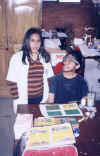 CEOLI has vocational programs for high school age children and older - baking/pastry
creation, jewelry design and making, and sewing/tailoring. Under the tutelage of a talented art teacher, Daniela, a
small group of young adults is also hand-painting notecards with colorful Bolivian scenes – men and women in their vivid native dress, llamas and
donkeys, all against the charming Andean countryside. Until just recently, the card-making has been for occupational therapy
only, although CEOLI has long wanted to turn it into a vocational activity. Believing the Bolivian market for selling cards to be too limited, CEOLI
wants to seek overseas markets to sell these cards. Ideally, this will generate income and jobs for a few handicapped young
people who might otherwise not have employment.
CEOLI has vocational programs for high school age children and older - baking/pastry
creation, jewelry design and making, and sewing/tailoring. Under the tutelage of a talented art teacher, Daniela, a
small group of young adults is also hand-painting notecards with colorful Bolivian scenes – men and women in their vivid native dress, llamas and
donkeys, all against the charming Andean countryside. Until just recently, the card-making has been for occupational therapy
only, although CEOLI has long wanted to turn it into a vocational activity. Believing the Bolivian market for selling cards to be too limited, CEOLI
wants to seek overseas markets to sell these cards. Ideally, this will generate income and jobs for a few handicapped young
people who might otherwise not have employment.
Several months ago Marvin and I decided to help sell the cards and develop markets in the U.S. As a start, we worked with the CEOLI staff to select designs, colors, card stock and packaging. Then we emailed friends, relatives, and Amizade associates, described the cards, and offered them for sale. Thus far we have sold 1302 cards, and CEOLI is thrilled. They are frantically working to complete the order in time for us to carry them back to the U.S. The cards sell for 75 cents U.S. each, and the kids will earn 50 cents of that, so there is a genuine earnings opportunity here. But the real key is developing long-term markets, generating on-going sales year after year. We have several idas on how to do that, but will wait until we return to the U.S. Here is a chance for us to make a significant difference in the lives of a handful of Bolivian youth, enabling them to become self-sustaining members of their society.We are heady with the possibilities. (Anyone who reads this and has ideas about how and where to sell these cards is heartily invited to contact us.)
The violence in Vinto two weeks ago ended our work at the orphanage, and we didn’t return
 there.After 3
there.After 3

 days
of house arrest in Cochabamba, Kristen returned home to Canada on schedule. Joyce and Marvin and I flew to Santa Cruz province (instead of La Paz as
we had originally planned) where we visited Samaipata (ancient pre-Inca ruins), Amboro National Park, and Las Cuevas
(another private park with beautiful waterfalls). After 3 days, Joyce returned to the U.S., and Marvin and I
stayed on in Santa Cruz city, a noisy, bustling and tropical city with all the flair and joi de vivre of its nearby neighbor, Brazil.
days
of house arrest in Cochabamba, Kristen returned home to Canada on schedule. Joyce and Marvin and I flew to Santa Cruz province (instead of La Paz as
we had originally planned) where we visited Samaipata (ancient pre-Inca ruins), Amboro National Park, and Las Cuevas
(another private park with beautiful waterfalls). After 3 days, Joyce returned to the U.S., and Marvin and I
stayed on in Santa Cruz city, a noisy, bustling and tropical city with all the flair and joi de vivre of its nearby neighbor, Brazil.
We have been back in Cochabamba a week now, and all is quietly back to normal. We are beginning to wrap up our lives here, finishing our various jobs, thinking about buying souvenirs and wondering how on earth we will find room in our suitcases for 1302 CEOLI cards and envelopes. Miracle of all miracles, our passports have finally returned, so we are now able to leave the country on schedule.
November 8, 2003
It must be godparent season, and apparently the opportunities for godparenting are creatively endless.Two months
ago, Moises (former mason’s helper, now a gardener at the Country Club and weekend handyman at Jean Carla’s house) and his wife Tatiana, asked us to be
the health godparents to their newborn son, Orlando Michell Sanches. After verifying that our responsibilities had more to do with general
growing up than with health (and heaven forbid, health insurance!), we accepted. Orlando will be baptized today, and his health mass will be tomorrow.
Two weeks ago we were caught off guard when Felix asked us to become godparents to his 3-year-old son Milton.Felix and Isabel’s older son Rodrigo already has a godparent, and they now wanted one for Milton. We were so delighted, and of course accepted. Little did we know until Jean Carla told us later, that Felix and Isabel had also considered asking us to be godparents of their new kitchen! I can only begin to imagine what the duties of kitchen godparents might be, but the possibilities are tastefully intriguing.
Thinking we were now fully loaded with godparent responsibilities, we were completely unprepared for a request to become godparents of the Viloma school graduating class of 2004. We couldn’t say no to that either.It is our chance at international fame – to have our pictures in the framed composite, along with the 30 graduates, hanging in perpetuity in the halls of Viloma school. Actually, the walls at Viloma school are mostly adobe, so they probably won’t make it until perpetuity. The Viloma school is one of Amizade’s next construction projects – it is currently an odd and motley collection of dilapidated buildings in the countryside (about 20 kilometers outside of Cochabamba), completely forgotten and ignored by the government. There are holes in the roof and walls, no ventilation, old U.S. pioneer bench-style desks. There are 3 decent blackboards for 500 students.The library is a 10 X 10 room with tattered maps lining one wall, and a small selection of unusable donated books in a dusty corner.The only reference book in the entire school is a small dictionary.
There are 30 students in the graduating class of 2004 (December). We visited with our new “god-students” and asked them what their plans were after graduation. But their plans are vague, their dreams stunted.Several are orphans, some are needed to work in the fields, one lives by himself in town because his family is too far away. How can they have aspirations to be teachers or nurses or technicians when there isn’t even enough money to buy lunch today, or a few pieces of school paper? Viloma school is scraping and fighting its way to provide a future for its children; the teachers and the community’s adults united and dedicated.There is a palpable energy here, a drive and hope that won’t quit among the community and school leaders. They believe that education is one of the keys to their kids’ futures, and they are desperately trying to change the old patterns of poverty. Being godparents of the Viloma graduating class of 2004 could be the most daunting of the godparenting responsibilities we have undertaken.
November 12, 2003
The days slide ever so slowly by now; minutes are hours, and hours are eternities, as if we were in a slow-motion dream, trudging endlessly toward a goal we will never reach. Our work here is almost done; only a few meetings with people and organizations remain, and our gifts and souvenirs are piling up and spilling haphazardly out our waiting suitcases. In the long stretches between our goodbye/wrap-up activities, I envision hugging my daughters again, melting down into their busy lives, tangled up in their love. I ache to feel the grasp of my granddaughter’s tiny hands, to be born again at the sight of her sparkling eyes and impish smile. I yearn to speak a language that I understand more than 90% of, and not having to guess the rest.
But I will miss the simplicity of our lives here, the ease with which we can focus on the reason we came.When you are surrounded daily by reminders of poverty and struggle, it is so much harder, so much more in-your-face, to think materialistically, be so self-centered. When you know personally the people who are striving to improve the harsh conditions of the Bolivian people, it is nothing short of cruel to walk away untouched.
We are part of these people’s lives now. Even when we return to that other life in the states, we will have responsibilities here, people we care about, ongoing intertwined lives and connections. Only the things – the clothes, the gifts, the books – are packed. Part of our hearts will remain. Parts of theirs we’ll carry inside us.
Now there won’t ever be a “going home”, for which place is really home – the place you already had in your heart, or the new one you just found room for? We did what we came to do.We found a small corner of the world where we could be of some help, and friends and organizations who enabled us to set about helping. We will return here someday.It is time to see our family and friends in the states again, but now we will be “home” no matter which place we go.